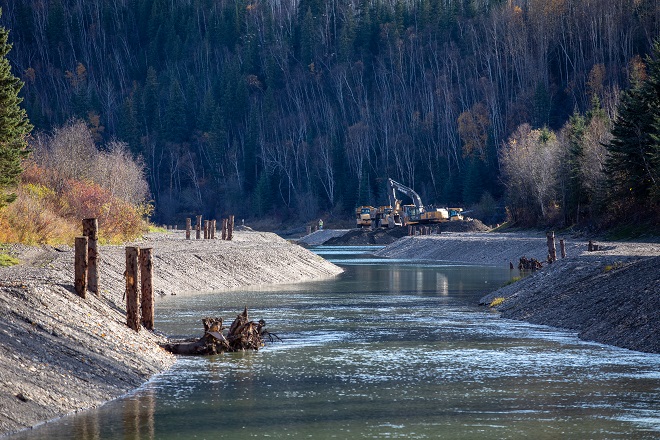Environmental Programs Nav

Downstream fish habitat enhancements
Protecting fish and the aquatic environment is an essential part of the Site C project. While the new reservoir will be able to support new and productive fish populations, we also know there will be changes to fish habitat, health and survival, and movement as a result of the project.
That’s why we’ve developed a thorough range of monitoring and mitigation programs to address these changes.
- Monitoring programs
- Upstream fish passage facilities
- Habitat enhancements
- Plans, studies and reports
Monitoring programs
Since the 1970s, we’ve been gathering data and studying baseline conditions in the Peace River and its tributaries from Peace Canyon Dam to Alberta. General surveys completed during the 1970s were followed by large-scale inventories of fish communities in the late 1980s and early 1990s.
Since 2005, numerous baseline studies have been completed to understand the abundance, size and age structure, distribution, and population structure of fish in the Peace River and its tributaries.
We developed the Fisheries and Aquatic Habitat Monitoring and Follow-up Program to monitor fish and aquatic valued components during the construction phase of the project (2015 to 2024) and the first 30 years of operation (2024 to 2053).
The Fisheries and Aquatic Habitat Monitoring and Follow-up Program is a coordinated set of 18 distinct programs that:
- Monitor fish and aquatic habitat during the construction and operation of the project.
- Help us understand the effects of the project and the effectiveness of mitigation measures.
- Evaluate and implement future mitigation and compensation options.
Programs:
- Fish population surveys: Monitoring the abundance, size and age structure, distribution, and population structure of fish in the Peace River and its tributaries.
- Bull trout spawning assessment: Assessment of bull trout spawning in tributaries of the Halfway River through aerial and ground surveys. Fish counters and tag detection systems are used to ground truth estimates of spawn timing, duration, and abundance.
- Fish movement monitoring: Monitoring changes to fish movement in the Peace River and its tributaries as a result of the construction and operation of the project.
- Creel survey: Monitoring the use of the Peace River and Site C reservoir for recreational angling.
- Physical habitat and riparian vegetation monitoring: Monitoring changes in physical habitat and riparian vegetation as a result of the construction and operation of the project.
- Fish food organisms monitoring: Monitoring the production of fish food organisms in the Peace River as well as Williston and Dinosaur reservoirs.
- Water and sediment quality monitoring: Monitoring water and sediment quality in the Peace River to evaluate the potential effects of the project.
- Fish entrainment monitoring: Monitoring the downstream movement of fish through the generating station.
- Total dissolved gas monitoring: Monitoring the generation of total dissolved gas and the associated effects on fish health and survival.
- Fish stranding monitoring: Assessment of fish stranding risk in the diversion headpond and Peace River downstream of the dam site.
- Fish passage monitoring: Monitoring the biological effectiveness of the temporary and permanent upstream fish passage facilities.
- Small fish translocation monitoring: Monitoring small fish populations in the Peace River to determine project impacts on genetic structure, movement, and genetic exchange of these species.
- Fish habitat enhancement monitoring: Monitoring the effectiveness of Peace River fish habitat enhancement measures near the dam site construction area to confirm suitability of habitat for fish.
- Water level fluctuations monitoring: Monitoring the effects of water level fluctuations on the catchability of fish and the biomass and production of periphyton in the Peace River downstream of the dam site.
- Tributary mitigation opportunities evaluation: Identification of fish habitat enhancement opportunities through habitat assessments in tributaries of the Peace River.
Upstream fish passage facilities
While the project is being built, and after it starts operating, the project will affect the ability of fish to migrate upstream past the dam site.
That’s why we’re building two upstream fish passage facilities – a temporary facility during river diversion, and a permanent one during dam operations. These are being put in place so that fish can continue to migrate upstream and fulfill portions of their lifecycles in the Peace River and its tributaries.
Migratory fish are naturally attracted to fast-flowing water. With this in mind, the temporary facilities are located at the outlet of the diversion tunnels and the permanent ones will be located at the future generating station, where fish will be attracted to the high flows. At the facilities, we’ll capture and tag the fish, before transporting them by truck upstream past the dam site.
Habitat enhancements
We're creating new or enhanced existing fish habitat in the Peace River to support many fish species, such as mountain whitefish, bull trout, and Arctic grayling.
Downstream of the dam site, the river levels will change following completion of the Site C project, which could cause areas to occasionally dry up and become unsuitable for the fish, algae and invertebrates that depend on permanently wetted habitats.
To counter this, we're increasing the amount of permanently wetted areas, by excavating the channels and placing habitat structures such as wood and boulders in the side channels to support fish in various stages of life.
In the Site C reservoir area, we're also enhancing shoreline habitat through shoreline shallow water habitat development and riparian vegetation planting.
These enhanced shoreline habitats provide valuable food and shelter for juvenile fish.
Learn more
- Fisheries and Aquatic Habitat Monitoring and Follow-Up Program PDF • 8.8 MB
- Fisheries and Aquatic Habitat Management Plan PDF • 1.43 MB
- Fish Passage Management Plan PDF • 2.36 MB
- Information sheet: Downstream effects PDF • 454 KB
- Information sheet: Fish and aquatic program PDF • 739 KB
- Information sheet: Fish habitat enhancement project PDF • 767 KB
- Information sheet: Fish passage facility PDF • 967 KB
- Information sheet: Tracking fish movements PDF • 1.4 MB
- Information sheet: Found a tag? PDF • 612 KB